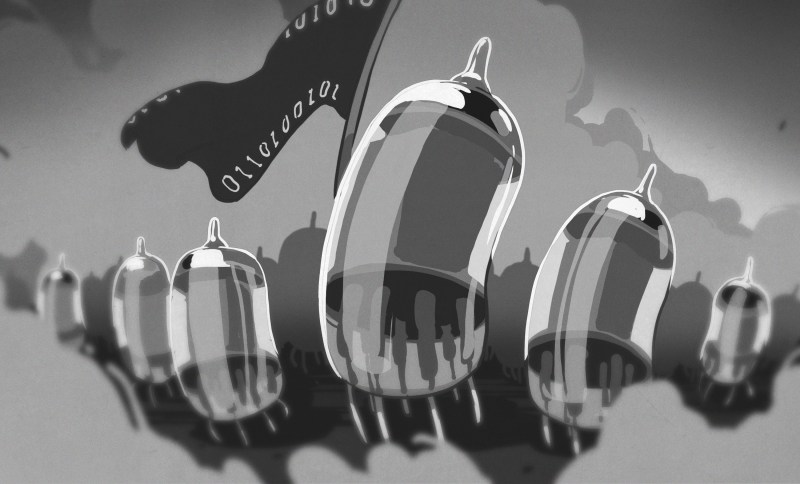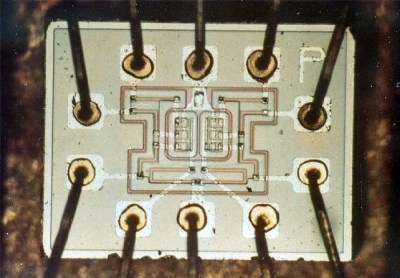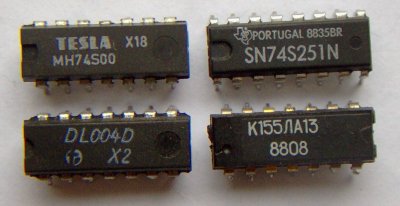TTL And CMOS Logic ICs: The Building Blocks Of A Revolution

When starting a new electronics project today, one of the first things that we tend to do is pick the integrated circuits that make up the core of the design. This can be anything from a microcontroller and various controller ICs to a sprinkling of MOSFETs, opamps, and possibly some 7400- or 4000-series logic ICs to tie things together. Yet it hasn’t been that long since this level of high integration and miniaturization was firmly in the real of science-fiction, with even NORBIT modules seeming futuristic.
Starting with the construction of the first point-contact transistor in 1947 and the bipolar junction transistor (BJT) in 1948 at Bell Labs, the electronics world would soon see the beginning of its biggest transformation to that point. Yet due to the interesting geopolitical circumstances of the 20th century, this led to a fascinating situation of parallel development, blatant copying of designs, and one of the most fascinating stories in technology history on both sides of the Iron Curtain.
A Smorgasbord of New Tech

After the invention of the transistor, it was of course not a simple matter of just slapping some transistors on a silicon die to create logic gates, putting it into a plastic (or ceramic) package, and taking over the world of digital electronics.
The first viable approach for creating logic gates with transistors in the early 1960s was resistor-transistor logic (RTL), which limited the number of transistors needed. At the time, resistors were cheaper and transistors were still hard to make. This approach was used with the Apollo Guidance Computer, which was built using discrete 3-input RTL-based NOR gates.
The competing diode-transistor logic (DTL) circuit technology had the advantages of using less power and allowing for significantly more fan-in (the number of supported inputs to a circuit), as well as for relatively easy increase of fan-out (number of outputs) by using additional diodes and transistors. A disadvantage of DTL was that the propagation delay through a circuit is relatively long due to the charge stored in the base region of the transistors.
This led to a number of attempts to control this saturation issue, including an added capacitor, a Baker clamp and the Schottky transistor. The early 1960s saw the release of DTL-based logic chips, with Signetics’ SE100 series, followed by Fairchild with the 930-series DTμL (micrologic) series. Following DTL was transistor-transistor logic (TTL), which is fairly similar to DTL, but as the name suggests, uses only transistors.
The first commercially produced TTL micrologic chips were Sylvania’s Universal High-Logic Level (SUHL) and the successor SUHL II series. Texas Instruments (TI) would introduce the 5400 TTL series for military applications in 1964, with two years later the 7400-series introduced for general applications.
Somewhat in parallel, emitter-coupled logic (ECL) also saw continuous success into the 1980s. The main advantage of ECL over approaches like RTL and DTL as well as TTL is that ECL is very fast due to its emitter-following nature, using a single overdriven bipolar junction transistor (BJT). The design is such that none of the transistors used are ever in saturation, with small voltage swings between high and low levels (0.8 V) that allow for relatively fast switching times.
Although ECL has the disadvantages of requiring relatively complicated power supplies with low noise, and drawing constant current, its high switching speeds made it an obvious choice in mainframes and other applications where speed was the most important factor. This included the Cray-1 super computer, as well as a range of IBM and VAX mainframes.
This contrasts with the development of the MOSFET (metal–oxide–semiconductor field-effect transistor), which saw its basic working principles already proposed in 1926, but took a much longer time to become ready for commercialization than the BJT, even though MOSFETs offer significant size and scaling advantages over these. Yet when MOS technology became ready for mass-production in the late 1960s, it caused a small revolution that enabled not just the still common 4000-series CMOS logic chips (introduced by RCA in 1968), but also the microprocessors that would power the home computer revolution of the 1970s.
Checking in with the CIA
Probably little of the preceding history is unfamiliar to the average reader, but where things get interesting is with the development of these technologies in the Soviet Union and allied nations. As this part of the world was on less-than-friendly relations with the US and allies since the 1940s, it got largely left out of the big semiconductor revolution that was taking place primarily in the US.
Essentially this meant that the manufacturing equipment and know-how for manufacturing transistors and MOSFETs was under strict embargo, with First World countries being forbidden from exporting any such items into the USSR and allied territories. When we look at a top secret 1976 CIA document (declassified in 1999) titled USSR Seeks to Build Advanced Semiconductor Industry With Embargoed Western Machinery, we can get a good impression of what the state of things were at that point in time.
Even as the US, Europe, and Japan were ramping up their respective semiconductor industries, the USSR was lagging severely behind. Although USSR leadership recognized the massive tactical advantage that modern semiconductor technology would give them, this was not a disadvantage that they would easily overcome. This led to a large-scale effort by the USSR to illicitly import Western machinery for manufacturing cutting-edge semiconductors and copy whatever technology they could get their hands on.
The Joys of Standards

Some of the result of this can be found in the many logic ICs that are compatible with 7400-logic series TTL ICs. While the European manufacturers would follow the Pro Electron naming scheme (e.g. FJH101 for the 7403 8-input NAND gate), the Soviet and to some extent Eastern Bloc manufacturers used the Soviet IC designation scheme. This began with the NP0.034.000 standard in 1968 which saw its first update in 1973 with GOST 18682—73.
Notable with IC logic chips produced for the Soviet market is that they use metric pin spacing (2.5 mm and 1.2 mm) rather than Imperial (2.54 mm and 1.27 mm). In Eastern Bloc countries like Czechoslovakia, Poland, and East Germany, various IC designation schemes were used, with many of them matching the Western equivalent. In East Germany, for example, three 7400 compatible series existed — 6400, 7400 and 8400 — each targeting a different market with different temperature ranges and other properties.

Even more confusingly, logic chips designated for export would sometimes be marked using the US-style 7400 designation. The use of Cyrillic lettering instead of Latin characters can also be very confusing, especially when a Cyrillic and Latin character look similar. The continued production of these series of logic ICs after the dissolution of the Soviet Union in 1991 at semiconductor plants which may not offer the printing of Cyrillic characters – forcing the use of romanized characters – has further muddled the naming here.
Transforming Iron into Silicon

For the people who lived in the USSR or any of its satellite nations, much of the technological revolution of the 1960s through the 1980s went largely by unnoticed. Due to the lack of semiconductor manufacturing capacity in the USSR, the ICs that got produced mostly found their way into military equipment and related, leaving lesser and outdated ICs for the average citizen, also resulting in valve technology surviving in the USSR for decades beyond in much of the West.
Yet with the fall of the Soviet Union, this all changed. With the embargoes against the USSR no longer in place, consumer goods filled with Western ICs flooded the markets in Eastern Europe and Russia, causing the rapid demise of companies like the Czechoslovak Tesla, which had been manufacturing pretty much all electronics for the local market there.
Military and other long-term contracts ensured that both the Soviet IC naming scheme and special ICs survive to this day, but the exciting days of spy-versus-spy of the Cold War have passed, leaving behind an oddly split history that will no doubt confuse many for decades to come.
[Heading image: The TU60 (timer circuit) part of 60-series NORBIT 2 family next to a CMOS integrated circuit. (Credit: Mister rf)]
Post a Comment